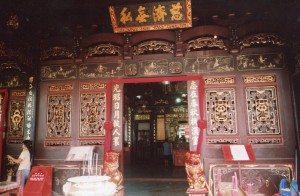K.C. Chang wrote that dragons were venerated in China at least 5,000 years ago. Now that’s continuity.
The Yangshao culture was a society of millet farmers who lived in lineage units in villages. It existed from 5000 to 3000 BCE. A Yangshao man was buried with a life sized dragon on his left, and an equally large tiger on his right. Both were made from clam shells.
Chang, in The Cambridge History of Ancient China, wrote that this man might have been a shaman. These two animals might have helped his spirit rise to Heaven.
Large dragons constructed on the ground with stones have been found in other very ancient cultures, including the Xinglongwa and the Daxi. Chang felt that many of these dragons were also associated with shamanism.
Westerners have seen dragons as nasty, scaly, fire-breathing beasts. Calvert Watkins, in How to Kill a Dragon, wrote that dragon-slaying myths go back to at least 1500 BCE in Indo-European literature. They can be found from India to Ireland.
But Chinese have seen dragons as more helpful and less antagonistic. They represent the energies in nature and will help you if you harmonize yourself with them.
Chinese ideas of dragons seem to have been established long before large states were built. Chinese culture has had even more continuity than most people realize.
I’m 40 hours away from flying to China for a month-long journey through its cultural landscape. I’ll explore its ancient heritage. I’ll also carry a little guitar that fits into my suitcase, and stay in hostels for most nights. So I’ll hopefully have a nice balance between traditions and the modern world. I’m looking forward to exploring China’s heart and sharing it with you in future posts.


{ 4 comments }
Did you leave out an “i” in Rig Veda above on Indian Culture, Part Five? I just tuned in on this compendium. Think I will enjoy when more time passes. Thanks for your work!
John, the “i” is more often inserted as a Western convention. The Sanskrit “r” is aspirated, somethat like a vowel. The Sanskrit alphabet has over 50 letters, and many are aspirated (called mahapranas–or great breaths), and different letters are classified according to where they’re pronounced–from the lower throat up to the teeth. So English and Sanskrit letters translate about as well as some of Facebooks rules:-). You’ll get a lot more from my posts on the Rg Veda by reading them in sequence from Part One. Please feel free to comment on Chinese culture too–you may notice that I haven’t posted much on it, and I still need to do the last part of the Forbidden City. I’m focusing on other cultures right now because I can post on China when I’m there in May and June, and I’ll have lots of other cultures to compare China with. Thanks for reading and commenting.
Thanks for pointing out the inherent issues in the romanization of Asian languages. I almost suppressed the confusion at the time I took Chinese in college. My Beijing-bred teacher at Sac State U taught the class in the Yale system. China was using the pinying system, as were the NY Times and some news media. However, almost 95% of printed books on art used the Wade-Gile system. With South and Southeast Asia, the British and French influences played their part. Changes are now evident in the current spellings of many names -Mumbai, Kolkata, Yangon, etc.
Thanks for your insights, John.
Comments on this entry are closed.